| Cover Story
The Mean Streets of Dhaka
Nader Rahman
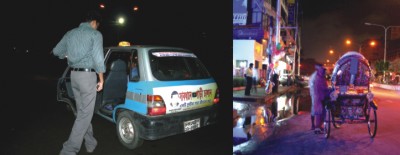 |
Traveling alone at night is a black cab is not advisable. |
On Friday July 20th a National Security Intelligence (NSI) official was found murdered in Mirpur and his body had been brutalised. His eyes seemed to have been gouged out, and there were marks all over his head and throat. The last his family had heard of him was when he got down off a bus and promised to return home by CNG within half an hour; that was at 7:30pm. By midnight his eldest son identified his body at the morgue and a family had been broken. When his body was brought home his daughter burst into tears and said that they were all supposed to go visit their village home soon, but now they will have to do so with her father's body. The story of murder is not an uncommon one in Dhaka but this particular case was eye-catching for one major reason. It brought to light the ever-worsening situation on the streets of capital, as the main suspects in the murder case were the recently prolific “aggan” and “mallam” party. It is thought that while the NSI official was on his way back home in a CNG one of the aforementioned parties got into the CNG with him and then beat him till he eventually died.
Dhaka has been a notoriously unsafe city for many years now, but recently the issue of safety on the roads has become one of prime importance. While it would be unfair to say that muggings and crime on the streets have gone up without statistical evidence to prove the point, what can be said is that there is an increased, fear factor these days as the common mans perception is that crime has gone up. People around the city have started to become extra cautious about where and how they travel, even in the daytime.
Rakib Khan (not his real name) a third year student of North South University (NSU) had the misfortune of being mugged twice and escaping from another. What is interesting about his story is that all three incidents occurred in different vehicles. As he says “The first incident was in Banani, it was pretty late at night and I hired a black cab to take me home. I was a bit tired but things seemed rather normal to me, as we got onto Banani road 11, things started to become shifty. I saw him on the phone and when we stopped at the end of the road to turn left I noticed two people watching me in the cab.” This is usually a red flag that something is not right. He went on to say “After we turned left the car went about 50 feet further and then stopped. The driver said he was having engine trouble and asked me to be patient. He got out and opened the bonnet of the car. I knew something was up and when I looked behind me, the two people who were checking me out earlier were walking briskly up to the car. I got out of the car and walked across the road and probably was saved from being mugged.”
This story has some indicators which most people should take notice of. Firstly when the driver of a cab in on the phone it is not a good sign, that is not to say every cab driver on the phone is planning to rob the passenger.
But generally it is not a good sign, also being watched by people after such an incident is another indicator of where the situation might lead to. Finally the oldest trick in the book is for the cab driver to say that he is having some form of car trouble. That gives him an excuse to stop or even slow down the car so that his accomplices can get into the car and complete the deal. The best indicator that Khan was going to be mugged was that after he got out and crossed the road, the driver did not protest and ask for his fare till then. Try doing that to a cab driver not planning to mug you and one will get more than an earful.
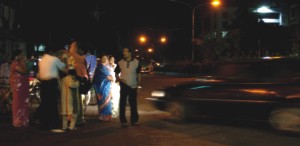 |
Getting home after a late night event is both difficult and risky for most people who don't have cars |
Khan's second incident was also symbolic of how most of the current muggings in vehicles takes place. “I took a beat up looking yellow cab to Mohammadpur at night and at first I was taken aback with the fact that he didn't want any extra money. When I got into the cab I asked him why the ac didn't work and why the cab was in such bad shape. He politely said that I should pay him whatever I thought should be the right fare for the journey. I was taken aback by his generous attitude. The whole time I was in the cab I was on the preoccupied and on my phone but then I started to realise things. He was on the phone as well and then we had come a long way and his meter still read only 20tk. I noticed them without making too much of it, I was still busily on the phone” He says. This is a common story for most commuters who see and feel something is wrong but do nothing about it, possibly because they are distracted.
He adds “Soon enough we were beside the Crescent lake behind Shangshad Bhaban, there he started to slow down and I didn't really notice anything. What I do remember was seeing two people cycle past the cab peering into it. Now I got worried and started to ask questions and was about to leave the cab when it started slowing even further. Within a few seconds three people were in the cab, one in the front and two in the back. At first they disorient you by shouting and threatening you. Then they calm down and get to their business. They pinned me down and searched me. They took my cell phone and my money. Then they started playing games with me saying my phone doesn't have a camera and they don't need it. They even left Tk 20 in my wallet for me to get home. All of a sudden they put some sort of ointment in my eyes and pushed me out of the cab.” This was what we now know to be the “mallam party”, the group that puts an ointment into the eyes of its victims and then robs them. His story is just one of many heard around the city. The pattern is startlingly similar even down to what the muggers say. This story of his also has some lessons to be learned from. When in a cab or any from of transport it is best not to be on the phone, that creates a distraction and immediately alerts the driver or anyone around the vehicle that you have an item of importance. Another lesson to be learned from the story is that if something seems wrong, the meter is not working or the driver is acting shifty it is best to just get out of the car and walk to safety. But this is only the case if the driver is involved with the mugging. For every mugging with a driver there is one without them and those can possibly be more dangerous.
While in the above-mentioned stories both forms of cabs are dealt with, CNG's are left out of the equation. There are two types of CNG muggings, ones which last a few seconds, those are usually at traffic signals and those in which two people enter the vehicle and it's essentially like the cab muggings. The ones at traffic signals are particularly innocuous, if the muggers spot one person in a CNG they will come from two sides and then politely ask for your belongings, they will usually show you a knife of gun and say if you scream then you are dead. You have nothing left to do but comply with them and usually hand them over without a fuss. By the time the traffic lights change they leave and within 30 seconds the deal has taken place. Stories of such ordeals are a dime a dozen these days. But that does not answer the question as to what to do with the current situation. The people of this city are essentially being held prisoners in their own homes. People are afraid to go out after dark and there is a general sense of public fear. For all of this to occur after the military backed caretaker government came into power is quite puzzling, the country has never seen such political stability.
Some people will say that the widespread eviction of hawkers and the price spiralling of essentials that have forced some of the more desperate to turn to crime. This may or may not have some weight. It is common knowledge that drug addicts are some of the main culprits behind the crime on the streets to support their deadly habits. The rise in muggings is more likely attributable to a lapse of security in the streets that have allowed criminals to rob and maim without much fear of getting caught.
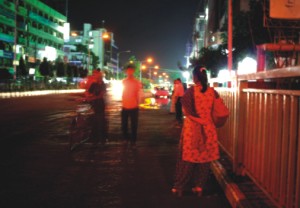 |
Streets at night are especially intimidating for women commuters |
The biggest problem that commuters face is a lack of readily available, reasonable and safe public transport. If the public transport system was wider and worked properly then more people would be tempted to take the bus and other safer forms of transport. For that to occur the government would have to take the issue seriously and devise a plan. Secondly while it would be unfair to call all cabs unsafe, it is more than a proven point that black cabs are particularly unsafe. The number of muggings and killings in black cabs attests to this. It would be best to stay clear of them.
Yellow cabs and CNGs are the other alternatives although many muggings take place in CNGs. Yellow cabs, moreover, are expensive and are not readily available which leaves the commuter back to taking a CNG or Mishuk.
There are of course simple, common sense measures to reduce the risks: sit to one side of the CNG so that people can not enter from both side, be alert at all times, never fall asleep, don't use your cell phone as it shows you have something worth stealing. But even when all precautions have been taken one is still not safe. This begs the question, where are the police? And what do they make of the current law and order situation?
The Challenges of Fighting Crime
Elita Karim
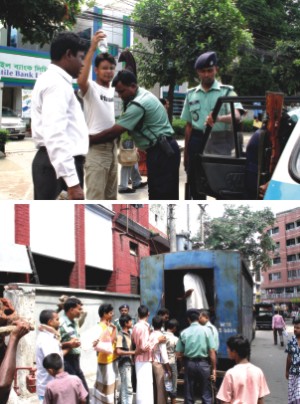 |
Despite increase in security checks and regular round ups, crime or the streets have been on the rise |
Like every other evening after work, Selina Ahmed hailed a CNG run auto from Kemal Ataturk Avenue in Banani and started towards home in Mohammadpur. It was 8:00 in the evening and the shutters were just beginning to close down at the nearby shops and supermarkets. As she sat herself inside the vehicle, putting down her bag, books and folders, she began to think of the official trip that she needed to make to Sylhet the very next day.
Suddenly, the vehicle swerved sharply and entered a dark alley. Selina jolted back to reality and immediately realised that something was definitely wrong. The next few moments were like a scene from a movie. Two men got into the vehicle from each side, punching her eyes and face. Selina tried to scream and before understanding what exactly was happening, the driver joined the thugs in strangling her with her own scarf. Selina was desperately trying to breathe and tell them that they could take whatever they wanted from her. She just wanted them to stop hurting her. The men held on to the struggling Selina and tied her hands, while strangling her at the same time. Suddenly she felt her eyes burning. The thugs forced a chilli powder mix into her eyes. They threw her out of the vehicle and sped away. "Now that I think of it, they probably wanted to kill Selina," says Ripa Ahmed, Selina's mother. "A security guard came to the rescue when she was screaming for help in the alley. We were informed and rushed to the spot. Selina's father immediately went to some of the RAB officials who were on duty nearby and told them about the incident and asked them for help. All they said was that he would have to go to Uttara to file a complaint. "We did not know what to do immediately, tend to our screaming daughter or dive to Uttara to make the complaint", says Ahmed. "We were hoping that the on duty RAB officials would be more helpful by immediately calling and informing the others on duty in and around the area about the incident which had occurred half an hour before we reached the spot."
Selina could not open her eyes for several hours and had to be admitted to a private hospital for four days. Even though two weeks have gone by since the incident occurred, Selina gets the shivers everytime she recalls what she had been through that night. Despite the fact that she is unable to walk properly and her eyes are bloodshot, Selina is going back to work. Even then, both she and her parents have been shaken up badly by the incident and refuse to expose their real names or photographs.
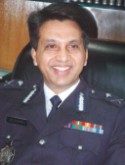 |
Noor Mohammad, IGP |
Over the last few decades, people of Dhaka have learnt to live with the everyday crimes that occur in the city. Gone are the days of petty offences like pick pocketing, snatching jewellery or even threatening a passer-by with weapons. The stories that come up nowadays are gruesome and make the citizens think twice before stepping outdoors in the evening. The streets are practically crawling with members of the Agyan Party and the Molom Party. They catch you while trying to commute from one place to another in Dhaka. Not only do they want to snatch all of your belongings, but also make sure that the victims remember the mugging incident by rubbing a chilli-mix paste in their eyes, hitting them, making them unconscious or stabbing them several times.
Many blame the law enforcers in the city who despite being stationed at various points all over the country, still find it difficult to cope with the every day crimes taking place on the streets. Even though the public feels that the crime rate on the streets has worsened and increased in the last few months, the police officials say otherwise. "According to our records and statistics, the rate has definitely decreased," says Noor Mohammad, the Inspector General of Police. He feels that due to the current boost in communication technology and media, incidents are now more visible to the general public. "We are doing everything possible to tackle this situation. For one thing we have increased the foot patrol, car patrol, we have installed both uniformed and plain-clothed police in many sections of the country and are also getting hold of the listed criminals. We are also trying to trace the origin of these members of the Agyan and Molom parties who come from many areas outside Dhaka. We are also trying to increase the visibility of law enforcers at the railway stations and bus stands where these incidents occur the most."
One of the areas where many such mugging incidents occur is Dhanmondi; a couple of months ago, Mishu a young man in his early twenties, was shot dead while being robbed of at least Tk 4,50,000. Both his parents are army officials. It is widely believed that it was the work of one the gangs in Dhanmondi. However, Monowar Hussain, the OC of Dhanmondi police station believes that no such gang actually hails from Dhanmondi. "These gangs come from areas outside Dhanmondi," he says. Though these members of these gangs belong to various age groups, most of them range between 20-22.
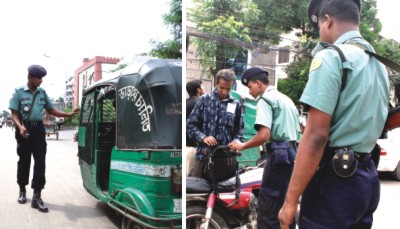 |
Police need to be paid better and given more time off for them to be efficient in fighting crime |
The OC of Uttara police station, Syed Nazrul Islam says that muggings have been categorised according to their types. For instance, street crimes committed by those on motorbikes belong to one category as opposed to the muggings taking place on CNG run autos and black/blue taxi cabs, belonging to yet another category. "After the Mishu murder case, I suggested at a police conference the very next day that close checking of vehicles should be done night and day in the city," says Islam. He believes that even though muggings done by bikers have decreased a whole lot in the city, incidents in the taxis and autos still face a threat to the regular commuting public. "Mugging cases happen in places where there is always a large gathering of people, for instance, at the bus stands, the railway stations and in front of the markets. I speak for Uttara when I say that check posts have increased and officials are always on the patrol. However, if you speak to the in-charge of the Biman Bondor Thana, you will discover a different story all together. Because lots of people happen to be there at all times of the day, many incidents of mugging and theft take place near the airport area."
In spite of the various steps taken by the officials to curb street crimes, police and RAB officials are often blamed for not doing their jobs properly. In many cases, law enforcers have been involved with gangs in many areas and demanded a share of what they 'earn' through mugging and other street crimes. Many people also fear police harassment, and do not even bother to register complaints at the police stations. "Most areas now have the model thanas which are designed in such a way that those who come to register their complaints are not intimidated," says Islam. He also explains why the legal process to prosecute these criminals is slow. "The other day we caught two young street muggers who also happened to be students from Asian University in Uttara. The cell phone that we retrieved from them could not be immediately returned to the woman who was the victim. We had to send it to the court, where after days of legal processing, the woman got her cell phone back. In such cases people have to be a little patient with us since we cannot overlook the law either."
"It is such a big city, that I have to admit that it gets very difficult for police officials to catch hold of every single criminal," says Noor Mohammad. He feels that with such limited facilities provided to the police officials in the country, improvement in this sector is very difficult. "We go through logistical problems, the officials have no incentives and our working conditions are not up to the mark. A constable works seven days a week, working long hours and hardly ever getting a leave for Eid or Puja festivals. These are humanitarian issues that the government and the media should look into." He adds that while in neighbouring New Delhi, the ratio of the police to the public is 1:200, in Dhaka it is 1:1200. "The other day I went to Fatullah thana in Narayanganj, I found the ratio to be 1:8000. We need support as well. A police person cannot be expected to work efficiently if he or she is not given his or her dues."
Recently, the government began an intense drive following an increase in crimes. The law enforcement agencies have been asked to better coordinate and intensify their operations. "The tag line of the police force, after it was established in 1861, was not to serve but to rule," says Mohammad. The various reforms that are taking place in this sector are now changing this idea. "Now it is serving rather than ruling. We have to create a sense of self-respect and dignity amongst the police officers so that they can perform." The creation of the National Police Commission will stimulate better exchange of inter-agency information before and during operations. The Police Complaints Commission is another part of the Police Reforms Programme, undertaken by UNDP, in collaboration with DFID and the European Commission, which will have a committee consisting of respected citizens of the country, members of the parliament and other men and women known to create a difference in the society.
Mohammad further feels that several positive changes are being made in the police department, where the officials were never free from pressures they frequently used to face earlier. According to a Daily Star report, Nur Mohammad, while addressing an audience at the inaugural day of 'Police Open Day' at Panchlaish Model Police Station in the Chittagong last week, said that the police department could never work independently when 'vested quarters' interfered with the appointment of officer-in-charge in police stations, where 'their' approval was always a must. "Now that the police is free from all kinds of pressure, interference from the political masters is not an option for the officers in charge."
Copyright
(R) thedailystar.net 2007 |
|
